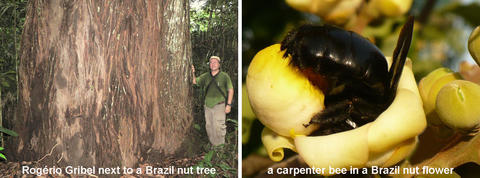This article was contributed by Rogério Gribel and Scott A. Mori.

Below is a video showing the pollination of Brazil nut flowers (Bertholletia excelsa) by carpenter bees (Xylocopa frontalis). We have been studying all aspects of Brazil nut classification, ecology, evolution, and conservation for most of our careers. In this blog, it is shown how essential big, strong bees are for the production of the largest "nut" found in a can of mixed party nuts. We put quotation marks around the word "nut" because Brazil nuts are seeds not nuts, a kind of fruit similar to an acorn. The seeds we eat at parties are produced in a woody fruit that looks like a cannnonball; thus, to be botanically correct Brazil nuts should be called Brazil seeds.
The flowers of a Brazil nut tree (Bertholletia excelsa) are relatively large (usually reaching three to four centimeters in diameter) and the petals and male part of the flower are cream-colored with a conspicuous patch of yellow at the entrance into the flower. The male part of the flower of this Amazonian tree possesses an elongated extension, called the ligule, from one side of a ring of fertile stamens that curves over the top of the ovary. No other plant outside of the Brazil nut family possesses a similar structure.
The ligule has two important functions, one is to keep non-pollinators from robbing nectar and pollen and the other to produce nectar that serves as a reward for legitimate pollinators. In addition, to the ligule blocking entry into the flowers, the petals press tightly against it thereby making entry into flowers even more difficult for nectar thieves. The bee pollinators, guided by the yellow spot at the entrance to the flower, force their way into the flowers, extract nectar from the ligule, and get dusted with pollen on their heads and back while inside the flowers (the yellow covering the bee in the video is pollen). The receptive stigma points to the outside of the flower so pollen is placed on it when the bees enter but not when they exit flowers thereby facilitating pollen transfer from one flower to the next. Although the bees visit other flowers in the same tree, pollen that is moved from one tree to another tree by these bees results in most of the seeds produced by Brazil nut trees.
Acknowledgments. The video was produced by Rogério Gribel and Aldenora L. Queiróz in the vicinity of Manaus, Amazonas, Brazil. They are grateful to the Instituto Nacional de Pesquisas da Amazônia and the Instituto de Pesquisas do Jardim Botanico do Rio de Janeiro for supporting their research on Brazil nut pollination.
Rogério Gribel is the Director of Scientific Research at the Rio de Janeiro Botanical Garden in Brazil. One of his research interests is the pollination, genetics, and conservation of the Brazil nut family.
Scott A. Mori is the Nathaniel Lord Britton Curator of Botany at the New York Botanical Garden. One of his specialties is the classification, ecology, and evolution of the Brazil nut family.
Add new comment